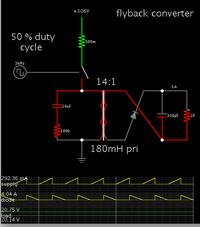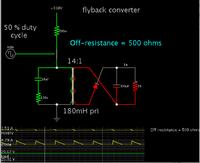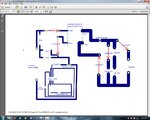Molectric
Newbie level 6
hello,
i am designing a converter to drive a high power LED(20W). the system has to be a single stage. so i have decided to use the flyback converter. however after building the converter and testing, i seem to draw too much current than expected. My maximum peak input current is 0.2904A from my design and simulations on POWER PSIM. the system i have designed is to be powered by an input voltage ranging from 306V to 338V. a transformer for the flyback converter that i am using is two coupled inductors.
the turns of the coupled inductor are:
Np=96
Ns=7
the inductances are:
Lp=10.53 mH
Ls=0.04842 mH
the length of the air gap:
Lg=0.146 mm
i am using a switch with the ratings, 1000V and 3A(IRFBG30)
the output rectifier diode i am using has the rating 200V and 8A. its an ultrafast diode.
the flyback conveter is suppose to step the voltage down to 20V and the output current is to be 1A.
I am drawing a cuurent of more than 1A at the input at voltages as low as 5V.
if there is anyone who might know the solution to my problem please help as soon as possible.
thanks
i am designing a converter to drive a high power LED(20W). the system has to be a single stage. so i have decided to use the flyback converter. however after building the converter and testing, i seem to draw too much current than expected. My maximum peak input current is 0.2904A from my design and simulations on POWER PSIM. the system i have designed is to be powered by an input voltage ranging from 306V to 338V. a transformer for the flyback converter that i am using is two coupled inductors.
the turns of the coupled inductor are:
Np=96
Ns=7
the inductances are:
Lp=10.53 mH
Ls=0.04842 mH
the length of the air gap:
Lg=0.146 mm
i am using a switch with the ratings, 1000V and 3A(IRFBG30)
the output rectifier diode i am using has the rating 200V and 8A. its an ultrafast diode.
the flyback conveter is suppose to step the voltage down to 20V and the output current is to be 1A.
I am drawing a cuurent of more than 1A at the input at voltages as low as 5V.
if there is anyone who might know the solution to my problem please help as soon as possible.
thanks



